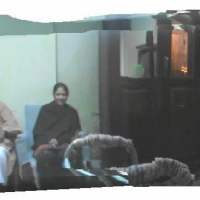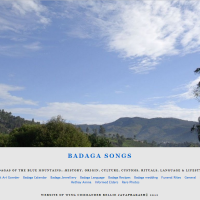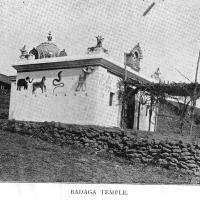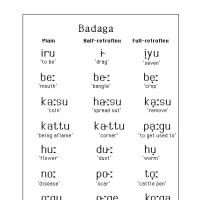MORAL: The attitude of negotiation and problem solving is to find the 18th camel i.e. the common ground. Once a person is able to find the common ground, the issue is resolved. It is difficult at times. However, to reach a solution, the first step is to believe that there is a solution. If we think that there is no solution, we won’t be able to reach any! If you liked this story… please share with friends, family and children… You might spark a thought, inspire and possibly change a life forever!![this story wasrecd as a fwd email]
Monthly Archives: October 2013
..Finding the 18th Camel!
Posted in badaga
Badaga Ballads
I am not too sure about the exact word in Badaga for ‘ballad’ – Could it be Paamay’ which also means ‘story?
[A ballad is a narrative poem, usually set to music; thus, it often is a story told in a song. Any story form may be told as a ballad, such as historical accounts or fairy tales in verse form. It usually has foreshortened, alternating four-stress lines (“ballad meter”) and simple repeating rhymes, often with a refrain. If it is based on a political or religious theme, a ballad may be a hymn (Wikipedia)].
There are quite a few ballads [‘traditional folk songs’] in Badaga narrating many stories that talk of the valour of heros [Kamarayya, Bala Sevana, Bela Madha], beauty of Badaga women [Giriji Madhi, Kolli Tippe], witchcraft of Kurumas , hospitality of Badagas [Unige Madha] etc.
I have heard these ballads narrated in a beautiful and melodious musical format by Kerban Bella Gowder and Kotagiri (Kurudu) Kada. Unfortunately both are dead now. Kada was blind but had an unique style of rendering these ballads and other Badaga songs. Of course, I can say without any hesitation that Bella Gowder’s songs were a sheer bliss to listen. His was the most accomplished voice. His SAVU SONGS can make the most hardened hearts melt and shed tears. He could create songs on the spot, known as – kadhe kattodhu
Listen to Kara Chenne – a great Ballad by Kerban Bella Gowder here :
The following information is found on the SPECIAL ISSUE of 1982 released by Kovai Badagar Sangam and I feel it deserves the attention of all of us who believe in our traditions, though some of the lines – the last few ones- are a little difficult to understand.
By Dr.K.K.Mathan M.Sc (Agri)., Ph.D
From the special issue published by Kovai BADAGAR SANGAM in 1982
We have heard about from where Badagas migrated, where they settled initially, what sort of dress they wore, the type of food they had and what type of houses they dwelled from many researchers. Badaga ballads and true epics are quite famous from these researchs. These ballads and epics have blended with our blood. Even a five year old would sing ‘HANAYA MANNU, SOLUR HENNU’ when asked.
A surprising information is that our ballads have been printed in book format nearly two hundred {now, 225years} ago ! we are proud to learn about that. A German has translated ‘HANAYA MANNU’ song into German language. The English version of the same written by H.B.GRIGG in 1880 appeared in the ‘MANUAL OF THE NILGIRIS DISTRICT IN THE MADRAS PRESIDENCY’ on pages 281-225.
I reproduce and dedicate the same for the information of all ;
BALA SEVANA
Once in the village of Hannia Mannu,
Near to the fortress of Koleya Kambe,
Lived there a youth named Bala Sevana,
Also, his brother, Bela-Madha.
Like were they to one another,
E’en as the spreading horns of a buffalo.
Nineteen men had Bela Madha,
Nineteen ploughed the land for Bala Sevana.
Once in the field of the gravel slope, they,
Met by the corner of the sacred seal stone;
First to Circar made they obeisance,
Then they made a salaam to the temple,
Folding their hands to the moon above them.
Deep in the earth they scooped a hollow,
Then they fetched an armful of hillus,
Played with a golden ball and with a Bat silver the game of Hillatta.
Lo ! the daughter of Yerugatta, The twice fallen Yerade – Bellie,
Took unto her eighteen maidens.
There stood she upon the green slope,
‘Neath the richly laden Khavilu;
There did she unbind her tresses,
Thick were they as the churn-stick, Mathu.
Meanwhile skillful Bala Sevana,
Caught the lillus of Bela Madha;
Madha caught not those of Sevana.
Then said Yeragatta’s daughter,
To twice fallen Yerada Bellie,
“Has not Bela in Temple”
In the grazing ground of Madha,
To the brim milked eighteen pailsful?
Then his loins with pure white kerchief Girt
he not and made the butter,
Made it with coir and churn of Pangni,
Allamaada was frame work?
Therefore Bela-Madha weary
Tho’ his have still their cunning
Widows sons are three times gifted.
But had skilful Bala Sevana
To the brim milked eighteen pailsful,
He forsooth had been too weary,
Poorly fed is Bala Sevana,
Drinking washings of the milk pails.
Art thou rich like Bela Madha?
Thus spake mocking Yerade Bellie.
Prone fell Bela ‘mid the rushes.
Bala Sevana too exhausted,
Fell among the Hubbe bushes.
See his face is dull and faded,
Which anon shone like the platter,
Fatal word of Yerade Bellie,
Word of dark and evil omens.
So the some time loving brothers,
Like were they to one another,
Even as the spreading horns of a buffalo
Part for aye from that same moments.
The ballad, which is very lengthy, goes on to relate the adventures of Bala Sevana, how he labored 12 years with his wife, became rich, performed heroic deeds and eventually was appointed the Chief Monegar of the Hills, receiving the seal of office from the cutcherry at Satiamangalam.
JP’s footnote :
HB Grigg’s’ Manual of the Nilgiris…’ can be accessed here
Here is another ballad called ” UNIGE MADA ” on the hospitality and love shown by Kinnakorai Joghee to a Kurum(b)a called Mada from Folktales of India By Brenda E. F. Beck
::::::::::::::::::::::::::::::::::
Badaga Villages [Hattis]
Hattis
Hi Sir ,
First and foremost my hearty congrats for your wonderful work.
I visited the site “https://badaga.co/badaga-villages-nakku-betta-hattis/”
I am from Bickatty village which is near to Akoni. Our village is mostly known by the name Akoni – Bickatty as there are lot of Hattis in this name.
Under Thodha Naadu Seeme our village is misspelt as Bikkatti. In most other places the spelling is as Bickatty. Could you please take my request(changing the spelling) into consideration.
Thanks a lot Sir.
With Regards
B.R.SATHEESH[Though I would like to mention the hatti names as pronounced/called by Badagas, I feel I must incorporate Satheeth’s suggestion. Pl let me know of any omissions/corrections. – Wg Cdr JP]

[All photos are by Bellie Jayaprakash and copyrighted. Reproduction without permission is illegal]
Badagas, generally, refer to their village or hamlet as ‘ HATTI ‘ spread around ‘Nakku Betta’ (the Nigiris). Nakku Betta literally means four (Nakku) Mountains (betta) though there are many hills around which the villages are located. It appears that initially when the Badagas established their hamlets, they took two very important factors into consideration. Being very environment conscious, they chose a) direction – always or to a very great extent facing the east [ ‘Hothu (sun) uttua (rising) pakka (side)’] and b) water souce – near a stream (halla) or spring (huttu neeru).Every hatti had a ‘suthugallu’ (sacred triangular shaped stone) at the base of a ‘bikka mara’ (tree) around which important meetings (Kootu) took place. For the most sacred of all Badaga festivals ‘Hethai Habba’ – always held on a monday (sovara), the collection of money (Hana kattodu) took place at the suthugallu in an elaborate ceremony on the preceding friday (belli). Let me write about Hethai Habba in a separate article.
The houses of each village were laid out in rows, each row facing the east. The houses had common walls (Gode mane) possibly as a measure of security. Every house had exactly the same configuration of Bayilu (entrance), Nadu mane (central-living/dining room), Oge mane (inner room) where cooking also takes place (kitchen) with a large beskatti (basket) above the hearth where drying takes place, Pillay (bathroom) and Ereh (a separate room adjacent to the bayilu). Of course, there was an attic on top of beskatti( kitchen having a hearth) the entry to which is from the nadumane. Again, we will discuss about a typical badaga house separately.
A cluster of villages, which need not be close to each other, is called a ‘Seemae’.
Though, so much is written and spoken about Badagas, it is a matter of great regret and concern that still the “EXACT” number of Badaga hattis is not known. The total number varies from 300 to 400. Though Rao Bahadur H.B. Ari Gowder is known to have sent his collegue HAIKA MATHI [literaly meaning horse man] Joghee Gowder of Bygemandu, in 1940s and 1950s to all the villages to know about the problems of Badagas, unfortunately there are no written records traceable.
Prof. Paul Hockings may be one of the earliest to mention the number and names of the hattis in his books.
In a laudable effort, Mr. K.H.Madha Gowder edited “NAKKU BETTA” magazine, had attempted to record all the hattis in one of its issues in late 1970s. I take this opportunity to list the villages as mentioned in ‘Nakku Betta’ hoping any omission/ incorrect mention will be brought to my notice so that the same can be included.
[Read the complete article HERE ]
Posted in badaga
Dr.Bhojan Anand – you make us proud !
There are many Badagas, spread around the globe, who have excelled in the field of academics and education. Some of the earliest ‘achievers’ are Prof. Sevannah (Bearhatty), a Mechanical Engineer who retired as the HOD from GCT, Coimbatore and Dr. Halayya (Muttinad) who was a professor in USA and VC of Dharwad University.
Here is another scientist whose career and profile should be an inspiration to all.
Dr Bhojan Anand, currently Senior Faculty in School of Computing, National University of Singapore, is probably the FIRST BADAGA SCIENTIST to receive “PhD in COMPUTER SCIENCE and ENGINEERING” from ASIA’s Number 1 and one of the World’s top 7 Universities in Engineering and Technology.
In 1994, after graduation with University First Rank in Computer Science (Bharathiyar University), he started his career as Lecturer in Computer Technology at NPA Centenary Polytechnic, Kotagiri. Published his first book on “Basics of Computer Applications”, widely used by polytechnic students together with my colleagues.
In the year 2000, he joined as Lecturer at School of Info-Communications technology, Singapore Polytechnic (he is one of the four members who were selected for this position in an All India level selection process arranged by the Polytechnics together with the Economic Development Board of Singapore).
In the year 2006, he joined as faculty at School of Computing, National University of Singapore completed his PhD degree in computer science and engineering with “Dean’s Graduate Research Achievement Award” at School of Computing, National University of Singapore.He has received PhD in Computer Science from National University of Singapore. He was a mentor and visiting scholar at MIT (Massachusetts Institute of Technology) Gambit lab (2008), USA.
He is from Siddha Kari Raju Gowder family, Konavakorai and son of Mr. K R Bhojan (KRB) and Mrs. Lakshmi Bhojan ( Betalada). Married to Florence (Kotagiri) and has two kids.
He has published on premier networking and multimedia conferences and has published five books on mobile computing and networks. He is invited speaker in international conferences and forums. He has received best-invited presenter award in M2M conference, organized by SIAA, Singapore and is honorary secretary of International Researchers Club, Singapore.
His full profile can be seen in www.comp.nus.edu.sg/~bhojan
[Information recd from Dr.Bhojan Anand in a personal email to me – Wg Cdr JP]
Badaga Weddings
Badaga customs and traditions are known for their simplicity, adaptability and practicality. In this respect a Badaga wedding follows a set of simple rules that has been almost the same over the centuries. But for a minor change here and there, it has been almost the same in all the villages spread across the Nakku Betta or the Nilgiri Hills.
The greatest plus points of a Badaga marriage are that there is NO DOWRY, the wedding always takes place in the boy’s (bride groom’s) house [or the place of his choice in case of a Kalyana Mandapam /Hotel] and all the wedding expenses including the customary feast [Maduve Hittu] of only vegetarian dishes, are borne by the groom’s family.
Incidentally, divorce and remarriges are not uncommon and a widow is not condemned for ever like in most of the Hindu communities and in many cases the widow can marry again even if she has children from her earlier marriage.
See a typical Badaga wedding in pictures here
Posted in badaga














 Mookuthi
Mookuthi  Chinna
Chinna 






 ==
==


![Seemae [See'may] & Morae [Mo'ray] (relationship)](https://i0.wp.com/badaga.wordpress.com/files/2008/11/nakku-betta1.jpg?resize=200%2C200)










































